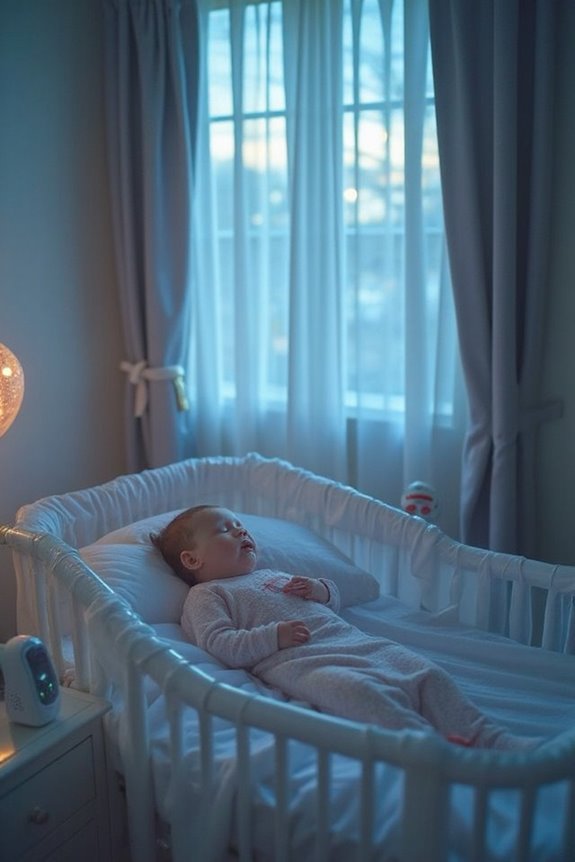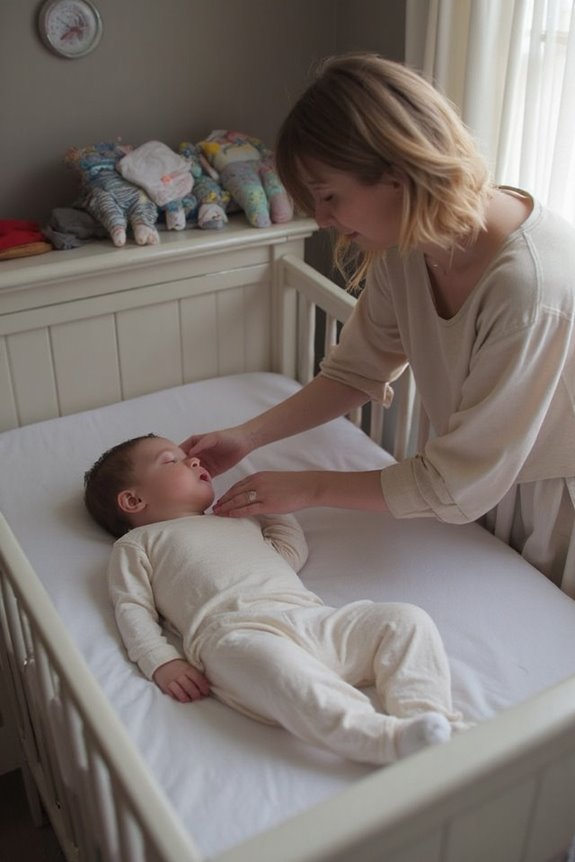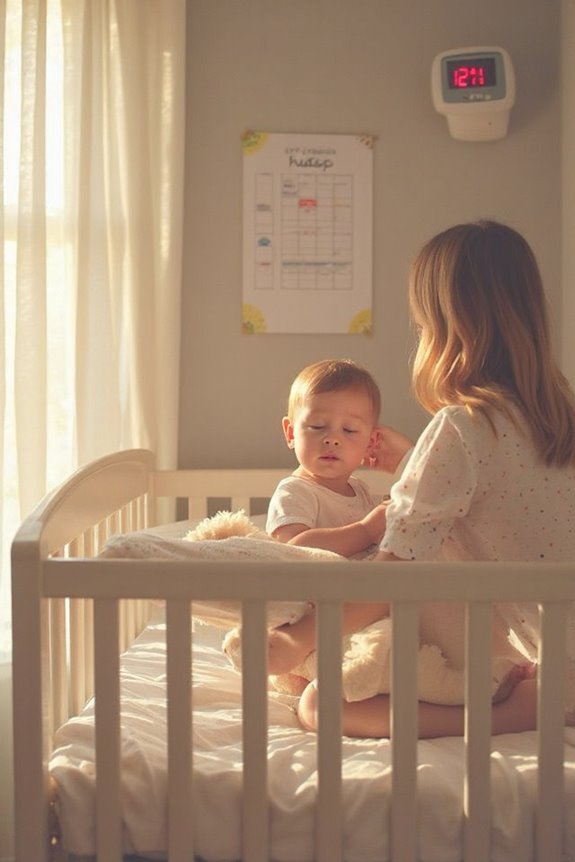To help your baby sleep peacefully in a bassinet, create a safe environment with a firm mattress and place the bassinet in your bedroom. Always put your baby on their back to sleep. Establish a consistent bedtime routine before 9 PM with calming activities like reading and singing. Keep the room temperature between 68-72°F and consider white noise to mask household sounds. The right combination of safety, routine, and comfort will set the foundation for successful sleep habits.
Key Takeaways
- Place baby on their back on a firm mattress in a bassinet positioned in your bedroom.
- Maintain a consistent bedtime routine with calming activities like reading, singing, and bathing.
- Keep room temperature between 68-72°F and use lightweight swaddling to prevent overheating.
- Use white noise and minimal lighting to create a soothing sleep environment.
- Establish consistent feeding schedules and appropriate wake windows to prevent overtiredness.
Creating a Safe and Secure Bassinet Environment
When you’re setting up your baby’s sleep space, safety must be your top priority. Following established bassinet safety guidelines considerably reduces risks while creating an environment that promotes healthy sleep hygiene.
To create a secure sleeping environment:
- Position the bassinet in your bedroom for at least the first six months
- Keep the bassinet away from windows, curtains, and electrical hazards
- Use only a firm mattress designed specifically for your bassinet model
- Dress your baby in snug-fitting sleepwear to prevent overheating
- Always place your baby on their back to sleep
I recommend regularly inspecting your bassinet for stability and wear. Verify it meets CPSC guidelines and confirm it hasn’t been recalled. Remember, a clutter-free area around the bassinet prevents tripping hazards during nighttime check-ins.
Establishing an Effective Bedtime Routine
Although many parents underestimate its importance, a consistent bedtime routine serves as the foundation for healthy infant sleep patterns. Research shows children with regular routines sleep over an hour longer per night and experience fewer night wakings.
For ideal routine benefits, I recommend:
- Starting before 9 PM each night
- Performing the same bedtime activities at least 5 nights weekly
- Including calming activities like reading, singing, and bathing
- Creating a gradual shift from wakefulness to sleep
- Avoiding stimulating activities before bedtime
The effectiveness of your routine depends on consistency. When implemented properly, your baby will not only sleep better but also develop improved emotional regulation and behavioral control. Be patient during the adaptation period—it’s worth the effort for both your baby’s sleep quality and your own well-being.
Selecting the Right Bassinet for Your Baby
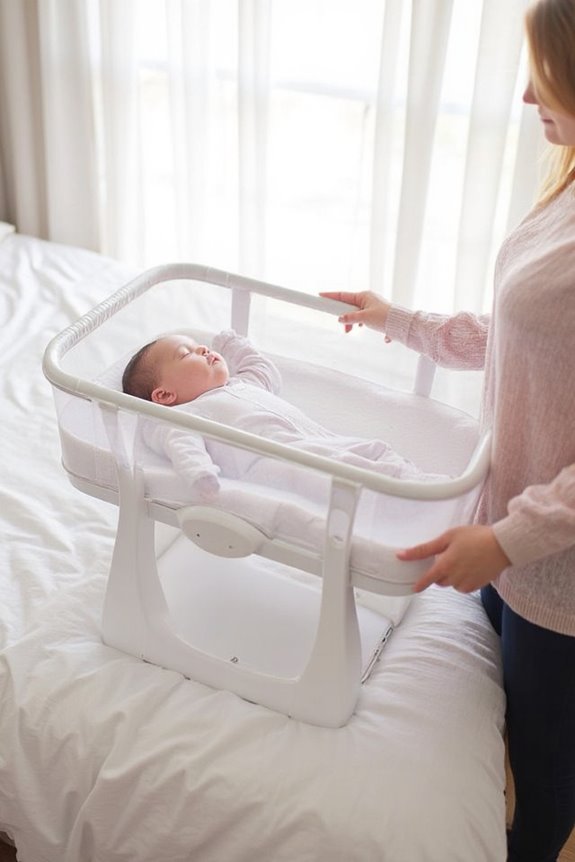
Choosing a safe bassinet for your baby isn’t just important—it’s crucial for your infant’s wellbeing during those critical first months. When evaluating bassinet features, I recommend focusing on:
- Structural stability with anti-tip mechanisms
- Sleep surface angle less than 10 degrees from horizontal
- Mesh sides for breathability
- Compliance with ASTM F2194 standards
Mattress quality cannot be overlooked. Select a bassinet with a firm, snug-fitting mattress that prevents any gaps where your baby could become entrapped. The mattress should be flat and not segmented.
I’ve found that portable models offer convenience for parents who want to keep baby nearby throughout the day. However, regardless of the style you choose, always verify the bassinet meets current CPSC regulations and doesn’t contain any loose items that could pose suffocation hazards.
Addressing Common Sleeping Challenges

Even with the perfect bassinet, many babies struggle with sleep issues that leave parents desperate for solutions. Understanding these challenges can help you address them effectively.
Consider these key factors:
- Temperature and comfort: Maintain room temperature between 68-72°F and use lightweight swaddling to mimic the womb environment
- Hunger management: Establish consistent feeding schedules and guarantee full feedings to prevent hunger-related waking
- Preventing overtiredness: Identify appropriate wake windows for your baby’s age to avoid the difficulty of settling an overtired infant
- Sleep environment: Place the bassinet in a quiet location with minimal light and consider using white noise
- Health considerations: Address issues like reflux or gas that might cause discomfort and disrupt sleep associations
For persistent problems, consult your pediatrician for personalized guidance.
When and How to Transition From Bassinet to Crib
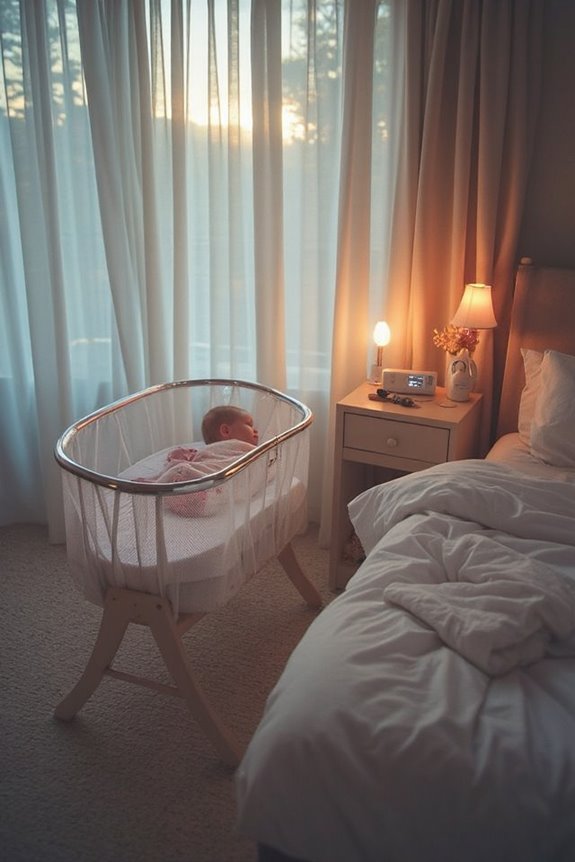
Moving your baby from a snug bassinet to a spacious crib marks an important milestone in their development. Most babies make this shift between 3-6 months, but you should always follow the weight and height limits specified by your bassinet manufacturer.
Shift timing considerations:
- When your baby can sit up or push up on hands and knees
- When sleep patterns begin to change
- Before they outgrow bassinet safety limits
The earlier you shift, the smoother it typically goes. I recommend starting with daytime naps in the crib while maintaining all crib safety standards, including:
- A firm, flat mattress
- No loose bedding or toys
- Proper assembly according to manufacturer guidelines
For a gradual adjustment, place familiar items nearby to help your baby feel secure in their new sleep space.
Essential Safety Measures for Nighttime Sleep
Whether you’re using a bassinet or crib, nighttime safety shouldn’t be left to chance. I recommend following these critical guidelines to protect your little one:
- Always place baby on their back to sleep, which reduces SIDS risk considerably
- Keep the bassinet in your room for at least six months for easy nighttime monitoring
- Make sure the bassinet meets CPSC safety standards
- Use only a firm mattress with tight-fitting sheets
- Remove all loose bedding, toys, and soft objects
Effective sleep training relies on consistency and safety. Maintain room temperature at a comfortable level and make sure proper ventilation is in place. Check your bassinet regularly for damage or wear, particularly if it has mobile features like wheels. Remember that approximately 1,400 babies die from SIDS annually – but following these guidelines greatly reduces this risk.
Frequently Asked Questions
Can Babies Dream While Sleeping in a Bassinet?
Yes, I believe your baby can dream while in REM sleep cycles, which make up about 50% of their sleep. While they can’t tell us, their active brain during this phase suggests dreaming occurs.
Should I Wake My Baby for Feedings During Bassinet Sleep?
Studies show 60% of newborns benefit from structured feeding schedules. I’d recommend waking your baby if they’re under 2 months or have weight concerns. Otherwise, I’d let natural sleep cycles guide their feeding patterns.
How Do I Handle Siblings Disturbing the Baby’s Bassinet Sleep?
I’d focus on sibling awareness by explaining baby’s need for rest. Create a special quiet time for older kids while baby sleeps, and use praise when they’re respectful of the bassinet area.
Can I Use Bassinet Wedges to Help With Reflux?
Like walking on thin ice, I’d avoid bassinet wedges for reflux. They’re not recommended for bassinet safety. Instead, I’d try dietary changes or consult your pediatrician about safer reflux management options without compromising sleep safety.
Is It Normal for Babies to Make Noises While Sleeping?
Yes, it’s completely normal for babies to make sleep sounds. Those gurgles, whimpers and grunts are part of their nighttime habits due to their small airways and developing digestive systems. I wouldn’t worry unless breathing seems labored.

